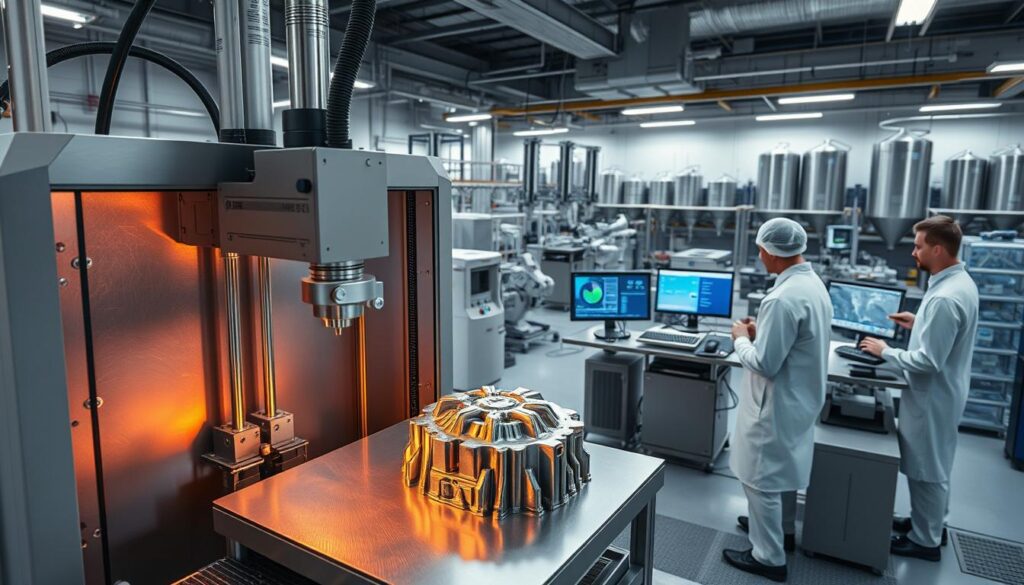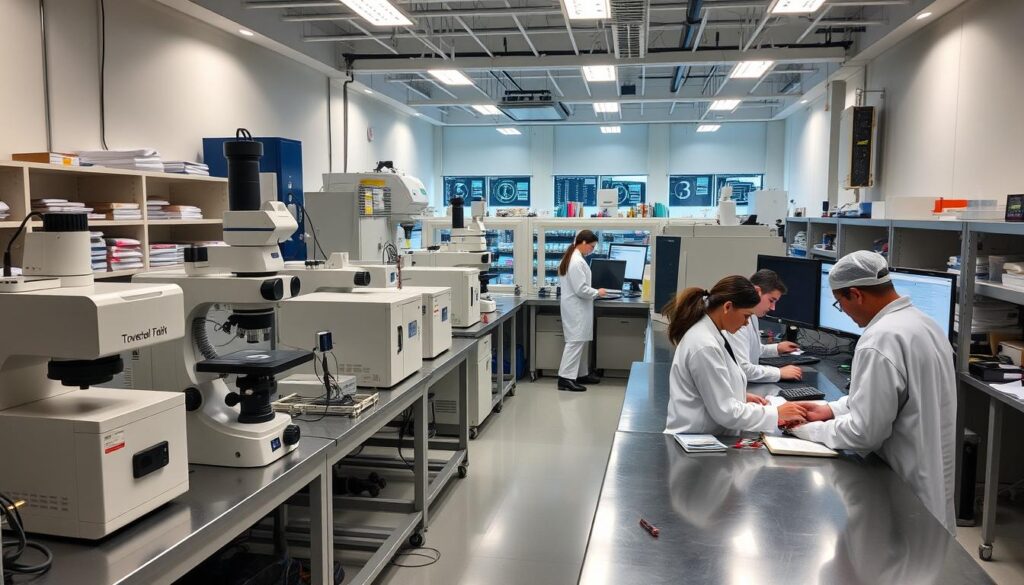Can the development of new materials revolutionize industries such as aerospace and automotive? The answer lies in metallurgical engineering, a field that plays a crucial role in shaping the future of materials.
Materials science is at the forefront of innovation, enabling the creation of stronger, lighter, and more durable materials. This, in turn, drives advancements in various sectors, from electronics to energy.
The importance of metal processing techniques cannot be overstated, as they are essential for transforming raw materials into the complex components used in modern technology.
Key Takeaways
- Metallurgical engineering drives innovation in various industries.
- New materials are being developed to meet the demands of modern technology.
- Advances in metal processing are crucial for the production of complex components.
- Materials science plays a vital role in shaping the future of industries.
- The development of new materials can lead to significant breakthroughs.
Introduction to Metallurgical Engineering
At the heart of modern technology lies metallurgical engineering, a discipline that has evolved significantly over the centuries. This field is crucial for developing materials that are used in a wide range of applications, from aerospace to consumer electronics.
What is Metallurgical Engineering?
Metallurgical engineering involves the study of the physical and chemical properties of metals and their applications. It encompasses the extraction of metals from ores, known as extractive metallurgy, and the development of new materials with specific properties, such as alloy design for enhanced strength or corrosion resistance.
The History of Metallurgy
The history of metallurgy dates back thousands of years, with early civilizations discovering and utilizing metals for tools and weapons. Over time, the techniques for extracting and processing metals have evolved, leading to significant advancements in metallurgical engineering. Today, this field continues to innovate, with research into new materials and processes.
Importance in Modern Industries
Metallurgical engineering plays a vital role in modern industries, including aerospace, automotive, and electronics. The development of materials with specific properties, such as high strength-to-weight ratios or resistance to corrosion, is crucial for the advancement of these industries. For instance, the aerospace industry relies heavily on advanced alloys designed for their strength, durability, and resistance to extreme temperatures.
| Industry | Application | Metallurgical Requirement |
|---|---|---|
| Aerospace | Aircraft Structures | High Strength-to-Weight Ratio |
| Automotive | Engine Components | Heat Resistance, Durability |
| Electronics | Conductors | High Electrical Conductivity |
By understanding the principles of metallurgical engineering, industries can develop more efficient, sustainable, and innovative products. The field continues to evolve, driven by the need for materials that can meet the demands of emerging technologies.
Key Concepts in Metallurgical Engineering
To grasp the complexities of metallurgical engineering, one must first understand its fundamental principles. Metallurgical engineering is a multifaceted field that involves the study of the physical and chemical properties of metals and their applications.

Metallurgical Processes Explained
Metallurgical processes are critical in transforming raw materials into usable products. Thermal processing is one such technique that involves heating and cooling metals to achieve desired properties. This process can enhance the strength, durability, and overall performance of metals.
The various metallurgical processes include:
- Smelting
- Refining
- Alloying
- Heat treatment
Each of these processes plays a vital role in producing materials with specific characteristics for different industries.
Materials Science Overview
Materials characterization is a crucial aspect of materials science, involving the analysis of the composition, structure, and properties of materials. Techniques such as X-ray diffraction and scanning electron microscopy are commonly used to understand the microstructure of metals.
Understanding the properties of materials is essential for selecting the right materials for specific applications. This knowledge helps in predicting how materials will behave under different conditions.
Corrosion and Its Impact
Corrosion is a significant concern in metallurgical engineering, as it can lead to the degradation of materials and structures. Understanding the mechanisms of corrosion and implementing preventive measures can help mitigate its impact.
Some common methods to prevent or reduce corrosion include:
- Applying protective coatings
- Using corrosion-resistant alloys
- Implementing cathodic protection
By addressing corrosion effectively, industries can enhance the longevity and reliability of their equipment and infrastructure.
Types of Metallurgical Materials
The versatility of metallurgical materials is evident in their various classifications, including ferrous, non-ferrous, and advanced alloys. These materials are fundamental to numerous industries, from construction and automotive to aerospace and electronics.
Ferrous Materials
Ferrous materials, which contain iron, are among the most widely used metallurgical materials. They are valued for their strength, durability, and versatility in mechanical applications. Steel, an alloy of iron and carbon, is a prime example, with its properties adjustable through various heat treatment processes.
“The development of steel has been pivotal in the advancement of modern infrastructure,” notes a leading metallurgist. “Its strength, coupled with its ability to be alloyed with other elements, makes it indispensable in construction and manufacturing.”
Non-Ferrous Materials
Non-ferrous materials, on the other hand, do not contain iron and are prized for their corrosion resistance, conductivity, and other unique properties. Aluminum, copper, and titanium are common non-ferrous metals used in metal processing for various applications, including electrical wiring, aircraft components, and marine hardware.
- Aluminum is lightweight and corrosion-resistant, making it ideal for aerospace applications.
- Copper is an excellent conductor of electricity, widely used in electrical components.
- Titanium offers high strength-to-weight ratio and corrosion resistance, suitable for marine and medical applications.
Advanced Alloys
Advanced alloys represent a significant evolution in metallurgical materials, designed to meet the demanding requirements of modern technologies. These alloys are engineered to possess superior mechanical properties, resistance to extreme temperatures, and other specialized characteristics.
For instance, superalloys used in jet engines can withstand extremely high temperatures, enhancing engine efficiency and performance. Similarly, shape-memory alloys can return to their original shape after deformation upon heating, opening up innovative applications in robotics and medical devices.
“Advanced alloys are at the forefront of technological innovation, enabling the development of more efficient, durable, and sustainable products,” according to a renowned expert in metallurgy.
Metallurgical Engineering Applications
From aerospace to electronics, metallurgical engineering applications are transforming industries. The field’s impact is vast, driving innovations and improvements in various sectors.

Aerospace Industry Innovations
The aerospace industry relies heavily on metallurgical engineering for the development of lightweight, high-strength materials. Advanced alloys are designed to withstand extreme conditions, including high temperatures and corrosive environments.
- Development of titanium alloys for aircraft structures due to their high strength-to-weight ratio.
- Use of superalloys in jet engine components for their ability to maintain strength at high temperatures.
Automotive Industry Developments
In the automotive sector, metallurgical engineering contributes to the creation of more efficient and safer vehicles. Alloy design plays a critical role in this, enabling the production of lighter vehicles with improved fuel efficiency.
- Application of high-strength steel in vehicle bodies to reduce weight while maintaining safety.
- Use of aluminum alloys in engine blocks and other components to decrease overall vehicle weight.
Electronics and Semiconductor Applications
Metallurgical engineering is also crucial in the electronics and semiconductor industries, where the development of materials with specific properties is essential. The creation of semiconductor materials and conductive alloys is vital for the production of electronic devices.
- Production of high-purity metals for use in semiconductor manufacturing.
- Development of lead-free solders for electronic assembly, driven by environmental regulations.
These examples illustrate the significant impact of metallurgical engineering across different industries, highlighting its role in driving technological advancements and innovation.
Metallurgical Testing and Analysis
Metallurgical testing and analysis are crucial steps in understanding the properties and performance of materials. These processes enable engineers to determine the suitability of materials for various applications, ensuring safety, efficiency, and cost-effectiveness.
Common Testing Methods
Several testing methods are employed in metallurgical analysis, including tensile testing, hardness testing, and impact testing. These tests provide valuable data on the mechanical properties of materials, such as strength, ductility, and toughness.
Materials characterization is a critical aspect of metallurgical testing, involving techniques like microscopy, spectroscopy, and diffraction to understand the microstructure and composition of materials. This information is vital for predicting material behavior under different conditions.
Role of Quality Control
Quality control plays a pivotal role in metallurgical engineering, ensuring that materials meet the required standards and specifications. Rigorous testing and inspection protocols are implemented to detect defects or deviations, thereby preventing material failures and enhancing overall product reliability.
Effective quality control involves not only the detection of defects but also the implementation of corrective actions to prevent future occurrences. This proactive approach is essential for maintaining high-quality production and customer satisfaction.
Advances in Testing Technology
The field of metallurgical testing is continually evolving, with advances in technology leading to more sophisticated and accurate testing methods. Techniques such as non-destructive testing (NDT) and computerized tomography (CT) scanning allow for detailed examination of materials without causing damage, facilitating more efficient and cost-effective testing processes.
Moreover, the integration of artificial intelligence (AI) and machine learning (ML) in testing and analysis is enhancing the accuracy and speed of material evaluation, enabling the prediction of material properties and behavior under various conditions, including corrosion resistance.
Environmental Considerations
As the world shifts towards more sustainable practices, metallurgical engineering plays a crucial role in reducing environmental impact. The industry is adopting greener technologies and processes to minimize its ecological footprint.

Sustainable Practices in Metallurgy
Sustainable practices in metallurgy involve the use of environmentally friendly processes and materials. This includes the adoption of extractive metallurgy techniques that minimize waste and reduce energy consumption. By optimizing thermal processing, metallurgists can improve the efficiency of metal production while lowering emissions.
Another key aspect is the use of renewable energy sources in metallurgical processes. By transitioning to solar, wind, or hydroelectric power, the industry can significantly reduce its reliance on fossil fuels and decrease greenhouse gas emissions.
Recycling of Metallurgical Materials
Recycling is a critical component of sustainable metallurgy. By reusing metals and materials, the industry can reduce the need for primary production, which is often more energy-intensive and environmentally damaging. Metal recycling not only conserves natural resources but also decreases waste and pollution.
- Recycling aluminum uses 95% less energy than producing it from raw materials.
- Steel recycling helps reduce the need for iron ore and coal, lowering emissions.
- Copper recycling is crucial due to its high conductivity and the energy required for its primary production.
Minimizing Waste in Metallurgical Processes
Minimizing waste is essential for reducing the environmental impact of metallurgical engineering. This involves optimizing production processes to generate less waste and implementing effective waste management strategies. Techniques such as zero-waste production are being explored to achieve this goal.
By adopting circular economy principles, metallurgical companies can reduce waste, reuse materials, and recycle products at the end of their life cycle. This approach not only benefits the environment but also enhances the industry’s sustainability and profitability.
Education and Career Paths
Metallurgical engineers play a crucial role in shaping the future of various industries by developing materials with enhanced mechanical properties. As the demand for advanced materials continues to grow, the field of metallurgical engineering offers a wide range of career opportunities.
Educational Requirements for Metallurgists
To become a metallurgical engineer, one typically needs to earn a bachelor’s degree in metallurgical engineering, materials science, or a related field. Coursework should include classes in materials science, thermodynamics, and mechanical engineering. Some positions may require a master’s or doctoral degree, especially for advanced research and development roles.
As noted by industry experts, “A strong educational foundation in metallurgical engineering is crucial for understanding the complex properties of materials and developing new technologies.”
“The future of metallurgical engineering lies in the development of sustainable materials and processes,” said Dr. John Smith, a renowned metallurgist.
Skills Needed in Metallurgical Engineering
Metallurgical engineers require a combination of technical and soft skills. Key technical skills include knowledge of materials characterization techniques, understanding of metallurgical processes, and proficiency in computer-aided design (CAD). Soft skills such as teamwork, communication, and problem-solving are also essential for success in this field.
- Knowledge of materials science and metallurgy
- Understanding of mechanical properties and materials behavior
- Proficiency in CAD and simulation software
- Strong analytical and problem-solving skills
Career Opportunities in the Field
Metallurgical engineers can pursue careers in various industries, including aerospace, automotive, electronics, and energy. They can work in roles such as materials development, quality control, and research and development. With experience, metallurgical engineers can move into leadership positions or start their own consulting firms.
According to the Bureau of Labor Statistics, employment of metallurgical engineers is projected to grow 4% from 2020 to 2030, as fast as the average for all occupations. This growth is driven by the increasing demand for advanced materials in various industries.
Emerging Technologies in Metallurgy
Emerging technologies are transforming the field of metallurgy, enabling new applications and innovations. The integration of advanced technologies is revolutionizing the way metals and alloys are designed, processed, and utilized.
Additive Manufacturing and 3D Printing
Additive manufacturing, commonly known as 3D printing, is a game-changer in metallurgical engineering. This technology allows for the creation of complex geometries and structures that were previously impossible to produce. It enables the rapid prototyping and production of metal parts with high precision and minimal material waste.
The applications of additive manufacturing in metallurgy are vast, ranging from aerospace to biomedical industries. For instance, it is used to produce customized implants and prosthetics with tailored mechanical properties.

Smart Materials and Their Applications
Smart materials are another emerging area in metallurgy, offering significant potential for innovation. These materials can respond to external stimuli such as temperature, light, or magnetic fields, making them ideal for various applications. Shape memory alloys (SMAs) are a prime example, used in medical devices, aerospace, and consumer products.
| Smart Material | Property | Application |
|---|---|---|
| Shape Memory Alloys | Can return to original shape after deformation | Medical devices, aerospace |
| Piezoelectric Materials | Generate electric charge under mechanical stress | Sensors, actuators |
Nanotechnology in Metallurgical Engineering
Nanotechnology is playing an increasingly important role in metallurgical engineering. By manipulating materials at the nanoscale, researchers can create metals and alloys with enhanced properties. Nanostructured materials exhibit improved strength, toughness, and corrosion resistance.
The applications of nanotechnology in metallurgy include the development of advanced coatings, catalysts, and energy storage materials. For example, nanoparticles are being used to enhance the performance of battery electrodes.
Challenges in Metallurgical Engineering
Metallurgical engineering, vital for advancing technology and infrastructure, is challenged by material failures, supply chain issues, and the need for continuous innovation. As the backbone of various industries, including aerospace, automotive, and electronics, metallurgical engineering plays a crucial role in developing materials that can withstand various environmental and operational stresses.
Addressing Material Failures
One of the significant challenges in metallurgical engineering is addressing material failures, often caused by corrosion, fatigue, or improper processing techniques. Enhancing corrosion resistance is critical, as it directly impacts the durability and reliability of materials used in harsh environments. Advanced metal processing techniques, such as alloying and surface treatment, can significantly improve material properties.
For instance, the development of new alloys with enhanced corrosion resistance can be achieved through careful selection of alloying elements and precise control over the manufacturing process. Additionally, applying protective coatings can further extend the lifespan of materials exposed to corrosive environments.
Global Supply Chain Issues
Metallurgical engineering is also affected by global supply chain issues, including the availability and cost of raw materials. Disruptions in the supply chain can lead to delays and increased costs, impacting the overall efficiency of metallurgical operations. To mitigate these risks, companies are adopting sustainable practices and exploring alternative sources for critical raw materials.
Furthermore, advancements in recycling technologies can help reduce dependence on primary raw materials, thereby alleviating some of the supply chain pressures. By closing the loop through recycling, metallurgical engineers can contribute to a more sustainable and resilient supply chain.
Competition and Innovation
The metallurgical engineering field is highly competitive, with companies continually striving to innovate and improve their products and processes. Staying ahead of the competition requires investment in research and development, as well as the adoption of new technologies such as additive manufacturing. Innovation in metallurgical processes not only enhances product performance but also reduces environmental impact.
To drive innovation, collaboration between industry, academia, and government is essential. By working together, stakeholders can identify emerging trends and technologies, fostering a culture of innovation that benefits the entire metallurgical community.
The Role of Metallurgical Engineers
The work of metallurgical engineers is fundamental to advancing various industries through innovative material solutions. Their role is multifaceted, involving a deep understanding of materials science and the ability to apply this knowledge in practical ways.
Daily Responsibilities
Metallurgical engineers are responsible for designing and developing processes for producing metals and alloys. Their daily tasks may include:
- Conducting experiments to improve material properties
- Analyzing data to understand material behavior under different conditions
- Collaborating with other engineers to integrate materials into product designs

Collaboration with Other Disciplines
Metallurgical engineers often work closely with professionals from other disciplines, such as mechanical engineers, chemists, and materials scientists. This collaboration is crucial for:
| Discipline | Role in Collaboration | Benefits |
|---|---|---|
| Mechanical Engineering | Designing and testing mechanical components | Improved product durability and performance |
| Chemistry | Understanding chemical reactions and material interactions | Enhanced material properties and safety |
| Materials Science | Developing new materials and understanding material behavior | Innovative material solutions for various applications |
Contributions to Research and Development
Metallurgical engineers contribute significantly to research and development, driving innovation in materials science. As noted by experts, “The development of new materials and processes is crucial for advancing technology and meeting future challenges” (
The future of materials science is closely tied to the advancements in metallurgical engineering.
).
Their work involves exploring new thermal processing techniques, developing advanced alloys, and improving recycling methods. By pushing the boundaries of what is possible with materials, metallurgical engineers play a vital role in shaping the future of various industries.
Future Trends in Metallurgical Engineering
Metallurgical engineering is on the cusp of a new era, driven by innovations in materials science and extractive metallurgy. As the demand for more sustainable and efficient materials grows, the field is responding with groundbreaking developments.
The Rise of Sustainable Materials
The shift towards sustainability is one of the most significant trends in metallurgical engineering. Sustainable materials are being developed to reduce environmental impact while maintaining or enhancing performance. This includes the use of recycled materials, bio-based materials, and materials that can be easily recycled or reused.
For instance, the automotive industry is increasingly adopting lightweight materials made from advanced alloys and composites to improve fuel efficiency and reduce emissions. Similarly, in the construction sector, sustainable materials like recycled steel and low-carbon aluminum are gaining popularity.
| Industry | Sustainable Material | Benefit |
|---|---|---|
| Automotive | Advanced Alloys | Improved Fuel Efficiency |
| Construction | Recycled Steel | Reduced Carbon Footprint |
| Aerospace | Lightweight Composites | Enhanced Performance |
Impact of AI and Machine Learning
Artificial Intelligence (AI) and Machine Learning (ML) are transforming metallurgical engineering by optimizing processes, predicting material properties, and improving quality control. AI algorithms can analyze vast amounts of data to identify patterns and predict outcomes, enabling more informed decision-making.
For example, AI can be used to optimize the smelting process by predicting the optimal temperature and chemical composition for extracting metals from ores. ML models can also help in predicting material failures, thereby reducing waste and improving safety.
The Role of Metallurgy in Renewable Energy
Metallurgical engineering plays a crucial role in the development of renewable energy technologies. Materials like rare earth metals, copper, and aluminum are essential for the production of solar panels, wind turbines, and other renewable energy infrastructure.
Advances in metallurgy are enabling the creation of more efficient and durable renewable energy systems. For instance, improvements in the production of high-purity silicon are critical for the efficiency of solar cells.
As the world continues to transition towards renewable energy sources, the demand for specialized materials will grow, driving further innovations in metallurgical engineering.
Professional Organizations and Resources
Professional organizations play a crucial role in the development and career advancement of metallurgical engineers. These organizations provide a platform for professionals to share knowledge, stay updated on industry developments, and access resources that are crucial for their work.
Key Metallurgical Associations
Several key metallurgical associations are prominent in the industry. The ASM International (ASM) is one such organization that is dedicated to advancing the field of materials science and engineering. ASM provides a wealth of resources, including publications, conferences, and professional development opportunities.
Another significant organization is The Minerals, Metals & Materials Society (TMS), which focuses on the advancement of materials science and engineering through education, research, and technology development. TMS offers numerous benefits to its members, including access to technical publications, networking opportunities, and professional development programs.

Resources for Continuing Education
Continuing education is vital in the field of metallurgical engineering due to the rapid advancements in technology and materials science. Professional organizations offer various resources for continuing education, including online courses, workshops, and conferences. For instance, ASM International offers a range of educational programs that cover topics from basic metallurgy to advanced materials characterization techniques.
“The key to success in metallurgical engineering lies in staying abreast of the latest developments and advancements in the field.” –
Networking Opportunities
Networking is a critical aspect of career development for metallurgical engineers. Professional organizations provide numerous networking opportunities through conferences, seminars, and local chapter meetings. These events allow professionals to connect with peers, share knowledge, and explore new opportunities.
- Attend conferences and seminars organized by professional associations.
- Participate in local chapter meetings to network with peers.
- Engage with online forums and discussion groups related to metallurgical engineering.
By leveraging these resources and opportunities, metallurgical engineers can enhance their professional development, stay updated on industry trends, and contribute to the advancement of the field.
Global Influence of Metallurgical Engineering
The impact of metallurgical engineering is felt across the globe, shaping industries and innovations. As the world becomes increasingly interconnected, the role of metallurgical engineering in developing and implementing advanced materials and processes has become more crucial than ever.
Metallurgy Around the World
Metallurgical engineering is not confined to any one region; it is a global field with significant contributions from various countries. For instance, countries like Japan and Germany are renowned for their advancements in metal processing and alloy design, driving innovation in automotive and aerospace industries.
The United States also plays a vital role, with numerous research institutions and companies pushing the boundaries of metallurgical science. “The development of new materials and processes is crucial for maintaining competitiveness in the global market,” says Dr. Jane Smith, a leading metallurgist.
Case Studies from Different Countries
Several countries offer compelling case studies on the successful application of metallurgical engineering. For example, Sweden’s steel industry has made significant strides in sustainability, reducing environmental impact through innovative recycling methods.
In China, rapid industrialization has driven demand for advanced metallurgical materials, leading to significant investments in research and development. This has positioned China as a major player in global metallurgical production.
Collaboration Between Nations
The global nature of metallurgical engineering necessitates international collaboration. Countries are working together to share knowledge, develop new standards, and address common challenges such as sustainability and resource management.
Through initiatives like the International Metallurgical Conference, experts from around the world come together to discuss the latest advancements and future directions in the field. This collaboration is essential for tackling global challenges and driving progress in metallurgical engineering.
The Intersection of Metallurgy and Other Fields
The versatility of metallurgical engineering is evident in its intersections with biomedical, chemical, and civil engineering. This interdisciplinary connection not only broadens the scope of metallurgy but also enhances its applications across various sectors.
Metallurgy in Biomedical Engineering
Metallurgy plays a crucial role in biomedical engineering, particularly in the development of implants and surgical instruments. Materials used in medical devices must have high corrosion resistance and biocompatibility. Techniques like materials characterization are essential in understanding the properties of these materials.
For instance, titanium alloys are widely used in orthopedic implants due to their strength, low density, and resistance to corrosion. The process of materials characterization helps in optimizing these alloys for better performance and longevity.

Relationship with Chemical Engineering
Metallurgy and chemical engineering are closely related, as both involve the processing and transformation of materials. Chemical engineers often work with metallurgists to develop new materials and processes, such as extractive metallurgy, which involves the extraction of metals from ores.
The collaboration between these two fields has led to advancements in corrosion resistance technologies, enabling the development of materials that can withstand harsh chemical environments.
Role in Civil Engineering
In civil engineering, metallurgy contributes significantly to the construction industry. Steel, an alloy of iron and carbon, is a fundamental material in building structures, bridges, and other infrastructure projects.
The selection of appropriate metallurgical materials for construction depends on factors like strength, durability, and resistance to environmental degradation. Techniques such as materials characterization are vital in ensuring that these materials meet the required standards.
By understanding the intersection of metallurgy with other engineering fields, we can appreciate the breadth of its applications and the potential for future innovations.
Metallurgy in Everyday Life
From household appliances to advanced medical devices, metallurgical engineering is omnipresent. The field’s influence on our daily lives is profound, often in ways we don’t immediately notice.
Everyday Applications of Metallurgical Engineering
Metallurgical engineering touches various aspects of our daily routines. For instance, the durability and efficiency of household items like cookware and cutlery are direct results of advancements in metallurgy. Stainless steel, an alloy developed through metallurgical engineering, is a staple in many kitchens due to its resistance to corrosion and ease of maintenance.
The automotive industry also benefits significantly from metallurgical advancements. Lightweight alloys and high-strength steels are used in vehicle manufacturing to improve fuel efficiency and safety. These materials are engineered through precise metallurgical processes, including thermal processing, to achieve the desired properties.
Importance in Home Appliances
Home appliances, ranging from refrigerators to washing machines, rely heavily on materials developed through metallurgical engineering. The longevity and performance of these appliances are enhanced by the use of corrosion-resistant materials and components engineered for durability.
| Appliance | Metallurgical Material | Benefit |
|---|---|---|
| Refrigerators | Aluminum | Lightweight, corrosion-resistant |
| Washing Machines | Stainless Steel | Durable, resistant to corrosion |
| Ovens | High-Temperature Alloys | Withstands extreme temperatures |
Metallurgical Advancements We Use Daily
Many daily used products owe their functionality and reliability to metallurgical advancements. For example, smartphones contain various metallurgical components, such as copper wiring and advanced battery materials, which are crucial for their operation.
The medical field also sees significant benefits from metallurgical engineering, with implants and surgical instruments made from materials that are not only durable but also biocompatible. These advancements contribute to improved healthcare outcomes and patient safety.
Conclusion: The Future of Metallurgical Engineering
Metallurgical engineering has evolved significantly, driven by advancements in materials science and extractive metallurgy. Understanding mechanical properties has been crucial in developing materials that meet the demands of various industries.
Key Takeaways
The field encompasses a broad range of topics, from the extraction of metals to the development of advanced alloys with specific mechanical properties. Innovations in metallurgical engineering have far-reaching implications, impacting industries such as aerospace, automotive, and electronics.
Shaping the Next Generation
As we look to the future, it’s essential to inspire young engineers to pursue careers in metallurgical engineering. By doing so, we can ensure continued innovation and progress in this vital field, leveraging advancements in materials science and extractive metallurgy to address global challenges.
